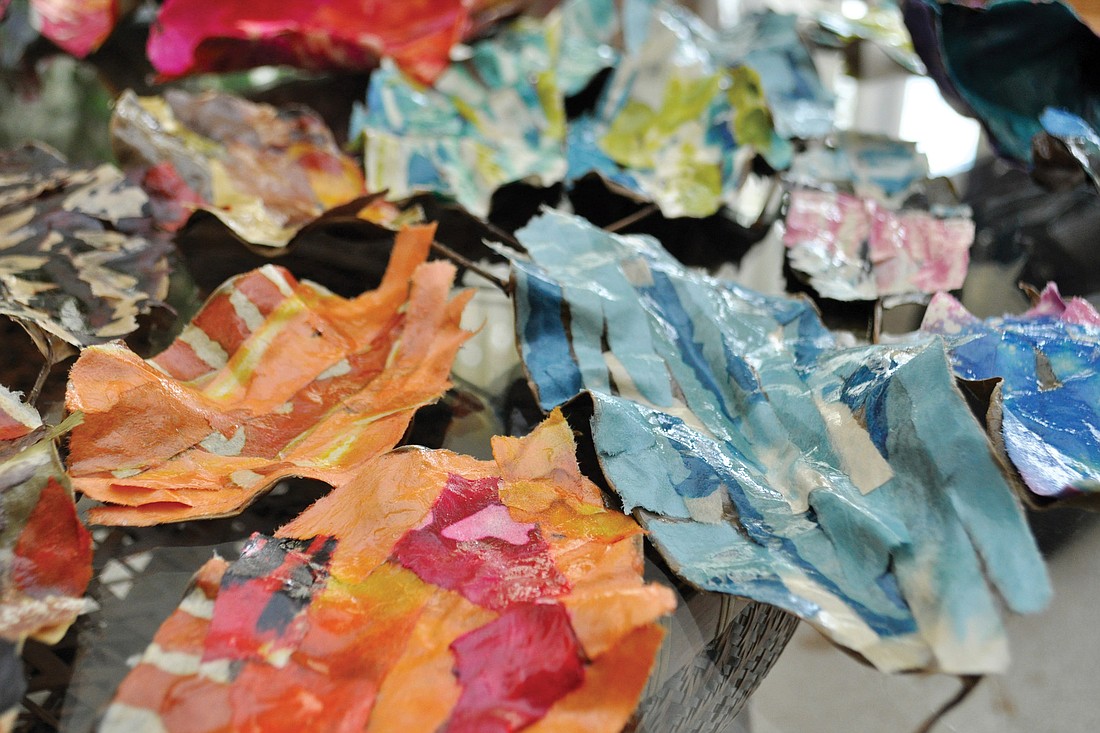- April 24, 2024
-
-
Loading

Loading

What another artist might discard, Jackie Peters Cully sees as another medium for her craft — she uses all of it.
A silk scarf in the making, sits on blank brown parchment paper. As she paints color on the fabric, dye seeps through onto the protective sheets of parchment below it. Cully then uses a roll of toilet paper to rub the ink into the silk.
The rolls of toilet paper, colored in streaks of bright dye, will next be used in a skirt she is producing in April for the iconcept fashion show fundraiser.
The leftover colorful parchment paper will be used for a special installation coming to Art Center Sarasota in May. Four hundred colorful leaves will hang from ceiling to floor — the result of a community project that she has initiated with the help of the Art Center.
“Oh, it’s a beautiful story,” she says of how the idea came formed.
It started when Cully found two leaves outside of her house. She brought them inside, and they sat on her bookshelf for six months.
Using polymer glue, she eventually covered the leaves with the dye-stained parchment from her latest textile design project, and they sat for another six months.
“I couldn’t figure out what to do with them, but I knew something would happen because that’s the way my life goes,” she says.
It was an artist friend of Cully’s, who, upon seeing the leaves, suggested she turn them into an art installation — Cully’s first. Cully could envision what it would look like, but she knew the project would need more leaves than she could produce on her own.
Cully recalled an article she read about a Nigerian artist who taught boys in his community how to flatten bottle caps for an installation on which he was working. The idea spurred the solution to her massive leaf installation.
“It’s going to be a community project,” Cully says.
No two leaves will be alike. They will all be different shapes, sizes and varieties; and a different person will design and decorate each side of the leaf.
Cully has already led three workshops at the Art Center to teach local children how to decorate the leaves.
“We’re (hoping) to do Boys and Girls (Club), Booker High School, The Friendship Center and the Women’s Resource Center, among other places,” she says.
The first workshop for adults was held Monday, Sept. 17. She plans to host at least one a month until the installation takes place. Cully tries to make six leaves a night. As a retired textile designer, her paper placement has a defined sense of purpose that reflects her artful eye.
In July, the installation will be moved to Florida Craftsman Gallery, in St. Petersburg. But Cully has aspirations for it to keep moving.
“You know what I hope?” she asks with hushed excitement. “That it goes to New York.”
New York City is a place she knows well; it was there that Cully achieved her childhood dreams. She was the first black stylist and textile designer in the United States.
“Since I was 5 years old, I knew I was going to be an artist,” Cully says.
When one of her high school teachers in Boston found out Cully (then Peters) was going to study at The Art Institute of Chicago, she told her that there was no place in the fashion market for a black artist.
“But I didn’t pay any attention to her,” Cully laughs. “I was going to be a fashion designer.”
While most women her age were getting married or studying to become secretaries, nurses or schoolteachers, Cully was attending art school in Chicago.
Around 1951, Cully moved to Paris to continue learning. After a year in one of the fashion capitals of the world, she returned home to Boston and began her search for a job as a dress designer.
“There were no black designers; just as my teacher said,” Cully says. She eventually moved to New York.
But, she was encouraged to pursue textile design when a Vogue editor saw her portfolio during an interview. It was a good fit. After 12 jobs in 12 years, Cully had made a name for herself.
“It was always upward, better jobs and bigger places,” she says.
Cully became well-known for her textile designs and was featured in many publications, from The New York Times to Ebony. She also sold her designs to the likes of Macy’s and Oscar de la Renta.
By 1966, Cully held one of the highest positions she could — a stylist at a design house. Then, in 1979, she took the next big career: She stepped out on her own to start Jackie Peters Design Studio.
By 1966, Cully was making an unheard of salary in the highest position she could hold — a stylist at a design house. Then in 1979, she took the next big career step going out on her own to start Jackie Peters Design Studio.
In 2000, Peters retired from textile design and moved to Sarasota, but she continues to make her mark on the world of design, one leaf at a time.
“I think if you have a passion, no matter what it is … don’t ever give up,” she says, “Stick around for the miracle that can happen in your life.”
To find out about Cully’s free leaf workshops, visit Art Center Sarasota’s website: artsarasota.org.